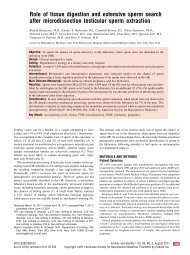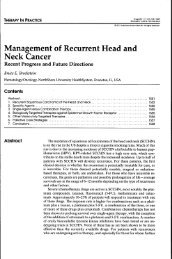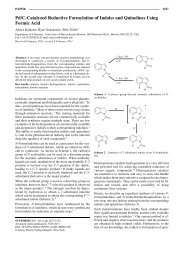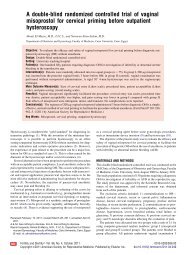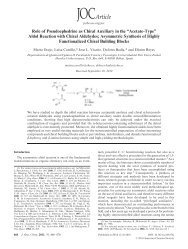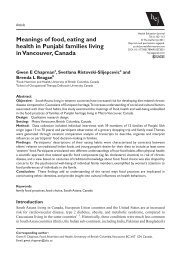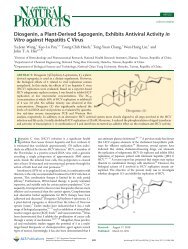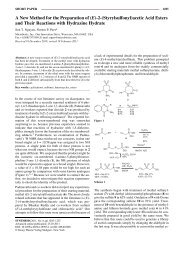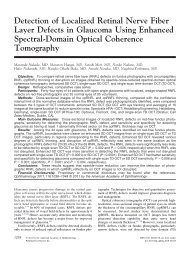Prenylated Polyhydroxy-p-terphenyls from Aspergillus taichungensis ...
Prenylated Polyhydroxy-p-terphenyls from Aspergillus taichungensis ...
Prenylated Polyhydroxy-p-terphenyls from Aspergillus taichungensis ...
Create successful ePaper yourself
Turn your PDF publications into a flip-book with our unique Google optimized e-Paper software.
Received: January 17, 2011<br />
Published: April 12, 2011<br />
ARTICLE<br />
pubs.acs.org/jnp<br />
<strong>Prenylated</strong> <strong>Polyhydroxy</strong>-p-<strong>terphenyls</strong> <strong>from</strong> <strong>Aspergillus</strong> <strong>taichungensis</strong><br />
ZHN-7-07<br />
Shengxin Cai, Shiwei Sun, Huinan Zhou, Xianglan Kong, Tianjiao Zhu, Dehai Li,* and Qianqun Gu*<br />
Key Laboratory of Marine Drugs, Chinese Ministry of Education, School of Medicine and Pharmacy, Ocean University of China,<br />
Qingdao 266003, People's Republic of China<br />
bS Supporting Information<br />
ABSTRACT: Six new prenylated polyhydroxy-p-terphenyl<br />
metabolites, named prenylterphenyllins A C(1 3) and prenylcandidusins<br />
A C (5 7), and one new polyhydroxy-pterphenyl<br />
with a simple tricyclic C-18 skeleton, named 4 00 -<br />
dehydro-3-hydroxyterphenyllin (4), were obtained together<br />
with eight known analogues (8 15) <strong>from</strong> <strong>Aspergillus</strong> <strong>taichungensis</strong><br />
ZHN-7-07, a root soil fungus isolated <strong>from</strong> the mangrove<br />
plant Acrostichum aureum. Their structures were determined by<br />
spectroscopic methods, and their cytotoxicity was evaluated<br />
using HL-60, A-549, and P-388 cell lines. Compounds 1 and 8<br />
exhibited moderate activities against all three cell lines (IC50<br />
1.53 10.90 μM), whereas compounds 4 and 6 displayed moderate activities only against the P-388 cell line (IC 50 of 2.70 and<br />
1.57 μM, respectively).<br />
Fungi have proven to be a valuable source of promising natural<br />
products. 1 Specifically, those metabolites reported <strong>from</strong><br />
specimens of the genus <strong>Aspergillus</strong> sp. have continually attracted the<br />
interest of the scientific community due to their structural diversity<br />
and potent biological activities. 1,2 This fungal genus has been<br />
subdivided into several subgenera and sections on the basis of conidial<br />
color and morphology. Members of the <strong>Aspergillus</strong> section Candidi,<br />
namely, A. candidus, A. campestris, A. <strong>taichungensis</strong>, andA. tritici, 3<br />
are known to produce a host of secondary metabolites including<br />
the terphenyllins, 3b,c candidusins, 3b,c chlorflavonins, 3b,c and xanthoascins.<br />
3b,c Most of these compounds are exclusive to this section, and<br />
in recent communications the terphenyllins and candidusins are<br />
regarded as chemotaxonomical indicators of the monotypic <strong>Aspergillus</strong><br />
section Candidi. 3 Their biological activities include antioxidant,<br />
cytotoxic, antimicrobial, and immunosuppressive properties. 4<br />
In our continued search for new anticancer compounds <strong>from</strong><br />
fungi associated with mangrove plants, 1b,2c,5 we observed that the<br />
ethyl acetate extract derived <strong>from</strong> the fungus strain ZHN-7-07<br />
exhibited intriguing UV profiles and cytotoxicity against the P-388<br />
(mice lymphocytic leukemia) cell line. This strain was isolated <strong>from</strong><br />
the root soil of the mangrove plant Acrostichum aureum and<br />
identified as <strong>Aspergillus</strong> <strong>taichungensis</strong>. Studies on the bioactive<br />
constituents of the extract led to the isolation of seven new<br />
polyhydroxy-p-terphenyl-type metabolites including six prenylated<br />
ones, prenylterphenyllins A C(1 3) and prenylcandidusins<br />
A C(5 7), and one exhibiting a more basic tricyclic<br />
C-18 skeleton, 400-dehydro-3-hydroxyterphenyllin (4), together<br />
with the known analogues prenylterphenyllin (8), 6 terprenin (9), 7<br />
deoxyterhenyllin (10), 8 3-hydroxyterphenyllin (11), 9,10 terphenyllin<br />
(12), 7 3,3-dihydroxyterphenyllin (13), 9,10 candidusin A (14), 11 and<br />
candidusin C (15). 3b The cytotoxicity of compounds 1 8 and<br />
11 15 was evaluated using HL-60, A-549, and P-388 cell lines.<br />
Herein, we report the isolation and structure elucidation of the seven<br />
new metabolites (1 7), as well as cytotoxic activities for compounds<br />
1 8 and 11 15.<br />
’ RESULTS AND DISCUSSION<br />
The isolated fungus A. <strong>taichungensis</strong> ZHN-7-07 was grown in a<br />
static liquid media. The culture broth was extracted with EtOAc,<br />
Copyright r 2011 American Chemical Society and<br />
American Society of Pharmacognosy 1106 dx.doi.org/10.1021/np2000478 | J. Nat. Prod. 2011, 74, 1106–1110
Journal of Natural Products ARTICLE<br />
Table 1. 1 H NMR Data for Compounds 1 7 (recorded in DMSO-d6) a<br />
1 2 3 4 5 6 7<br />
position δH (J in Hz) δH (J in Hz) δH (J in Hz) δH (J in Hz) δH (J in Hz) δH (J in Hz) δH (J in Hz)<br />
2 6.69, d (1.9) 7.09, brd (8.7) 6.43, d (1.8) 6.70, brd (1.8) 7.39, s 7.46, s 7.42, s<br />
3 6.75, brd (7.8)<br />
5 6.71, d (8.2) 6.75, brd (7.8) 6.72, brd (8.3) 7.09, s 7.45, s 7.39, s<br />
6 6.54, dd (8.2, 1.9) 7.09, brd (8.7) 6.57, d (1.8) 6.56, dd (8.3, 1.8)<br />
3-OH/OMe 8.75, brs 9.06, brs 8.78, brs 9.11, brs 3.87, s 9.05, brs<br />
4-OH/OMe 8.75, brs 9.31, brs 9.06, brs 8.78, brs 9.45, brs 3.88, s 3.89, s<br />
50 6.35, s 6.36, s 6.37, s 6.43, s 6.70, s 6.74, s 6.72, s<br />
20-OH 8.42, brs 8.50, brs 8.41, brs 8.55, brs<br />
30-OMe 3.30, s 3.29, s 3.29, s 3.30, s 3.78, s 3.80, s 3.80, s<br />
60-OMe 3.63, s 3.63, s 3.63, s 3.65, s 3.98, s 4.00, s 3.99, s<br />
200 7.31, d (2.3) 7.31, d (1.9) 7.43, d (8.2) 7.62, brd (8.3) 7.29, d (2.3) 7.30, d (2.3) 7.30, d (1.9)<br />
300 6.84, d (8.2) 7.46, dd (7.8, 7.8)<br />
400 7.39, dd (7.3, 7.3)<br />
500 6.86, d (8.2) 6.85, d (7.8) 6.84, d (8.2) 7.46, dd (7.8, 7.8) 6.88, d (8.2) 6.88, d (8.3) 6.89, d (8.6)<br />
600 7.25, dd (8.2, 2.3) 7.24, dd (7.8, 1.9) 7.43, d (8.2) 7.62, brd (8.3) 7.25, dd (8.5, 2.3) 7.24, dd (8.2, 2.3) 7.25, dd (8.2, 2.3)<br />
400-OH 9.45, brs 9.45, brs 9.48, brs 9.45, brs 9.45, brs 9.48, brs<br />
1000 3.27, d (7.3) 3.26, d (7.3) 3.22, d (7.3) 3.29, d (7.4) 3.29, d (7.4) 3.30, d (7.3)<br />
2000 5.34, t (7.3) 5.33, t (7.3) 5.29, t (7.3) 5.36, t (6.9) 5.36, t (6.9) 5.36, t (6.9)<br />
4000 1.70, s 1.70, s 1.67, s 1.71, s 1.70, s 1.71, s<br />
5000 1.69, s 1.69, s 1.66, s 1.71, s 1.70, s 1.71, s<br />
a 1<br />
Spectra were recorded at 600 MHz for H NMR using TMS as internal standard.<br />
and the organic extract was separated using normal-phase silica<br />
gel followed by Sephadex LH-20, to be finally purified by<br />
semipreparative HPLC to yield compounds 1 15.<br />
Prenylterphenyllin A (1) was obtained as a colorless, amorphous<br />
solid, and its molecular formula was established as C25H26O6 on the<br />
basis of HRESIMS data {[M þ H] þ ion at m/z 423.1814, calcd<br />
423.1808; Δ þ1.5 ppm}. The formula above was consistent with the<br />
1 Hand 13 C NMR data and indicated 13 degrees of unsaturation. The<br />
1 Hand 13 C NMR data of compound 1 displayed resonances that<br />
were assigned to 12 quaternary carbons, eight methines, one methylene,<br />
two methyliums, and two methoxyl groups (Tables 1 and 2).<br />
Thesedatawereverysimilartothoseoftheknownmetabolite<br />
3-hydroxyterphenyllin (11), 9,10 except for the lack of one aromatic<br />
proton and the appearance of an additional isoprene unit. The basic<br />
polyhydroxy-p-terphenyl skeleton in 1 was confirmed by 1 H 1 H<br />
COSY and HMBC correlations (Figure 1). The isoprene moiety was<br />
elucidated via HMBC correlations <strong>from</strong> H-4 000 and H-5 000 to C-2 000<br />
and was assigned at C-3 00 on the basis of HMBC correlations <strong>from</strong><br />
H-1 000 to C-4 00 and <strong>from</strong> H-2 00 to C-1 000 (Figure 1). Thus, we concluded<br />
the structure elucidation of compound 1 and named it<br />
prenylterphenyllin A.<br />
Prenylterphenyllin B (2) was separated as a colorless, amorphous<br />
solid. An [M þ H] þ molecular ion at m/z 407.1850 (calcd<br />
407.1858; Δ 2.1 ppm) in the HRESIMS spectrum was in<br />
agreement with the molecular formula C25H26O5. Their similar<br />
UV absorptions suggested that 2 was an analogue of 1.Comparison<br />
of the NMR data for the two compounds suggested that they had<br />
the same substructures of rings B and C, with the main differences<br />
located on ring A. Specifically, analogue 2 showed the absence of<br />
one hydroxyl group and the presence instead of one additional<br />
hydrogen to outline a 1,4-disubstituted benzene ring in compound 2<br />
(Table 1). Thus, compound 2 was elucidated as a dehydroxyl<br />
analogue of prenylterphenyllin A (1).<br />
Prenylterphenyllin C (3) was a colorless, amorphous solid,<br />
and HRESIMS indicated the molecular formula C25H26O6. Compound<br />
3 displayed similar NMR resonances to the already reported<br />
metabolite 8, 6 and their comparison suggested that they shared the<br />
same substructures of rings B and C. However, the absence of three<br />
signals for several aromatic protons in 8 (δH 6.77, d, J =8.3Hz,δH<br />
6.91, dd, J = 8.2, 2.3 Hz, and δH 6.95, d, J = 2.3 Hz) and the presence<br />
of an additional deshielded hydroxyl group singlet (δH 9.06, brs), as<br />
well as two new aromatic protons (δH 6.43, d, J = 1.8 Hz, and δH<br />
6.57, d, J =1.8Hz)in3, suggested that the latter compound<br />
exhibited a 1,2,3,5-tetrasubstituted ring A. Therefore, the structure<br />
of compound 3 was determined as prenylterphenyllin C.<br />
The molecular formula of 4 was determined as C20H18O5 on<br />
the basis of an [M þ H] þ ion at m/z 339.1230 (calcd 339.1232;<br />
Δ 0.7 ppm) in the HRESIMS. Similarities in the NMR data<br />
(Tables 1 and 2) of compound 4 and known deoxyterhenyllin (10) 8<br />
showed that their structure was closely related with the exception<br />
of 1 H NMR data for ring A in 10 (δH 6.77, 2H, brd, J =8.4Hzand<br />
δH 7.06, 2H, brd, J = 7.9 Hz), which were replaced in 4 by<br />
resonances consistent with a 1,2,4-trisubstituted benzene<br />
(Table 1). Additionally, this new entity exhibited the presence<br />
of a second deshielded hydroxyl group (δH 8.78), suggesting<br />
the replacement of an aromatic proton in 10 by a hydroxyl<br />
group in 4. Thestructureof4 was further confirmed by the<br />
HMBC correlations shown in Figure 1. Thus, the structure of<br />
4 waselucidatedas4 00 -dehydro-3-hydroxyterphenyllin.<br />
Prenylcandidusin A (5) was found to possess the molecular<br />
formula C25H24O6 as determined by HRESIMS and consistent<br />
with 14 degrees of unsaturation. Careful comparison of the NMR<br />
data for 1 and 5 (Tables 1 and 2) revealed that they had almost<br />
identical 1 H and 13 C resonances except for the absence of one<br />
hydroxyl group peak at δH 8.42 (brs), the H-6 proton at δH 6.54<br />
(dd, J = 8.2, 1.9 Hz), and a noticeable downfield chemical shift for<br />
1107 dx.doi.org/10.1021/np2000478 |J. Nat. Prod. 2011, 74, 1106–1110
Journal of Natural Products ARTICLE<br />
Table 2. 13 C NMR Data for Compounds 1 7 (recorded in DMSO-d6) a<br />
1 2 3 4 5 6 7<br />
position δC, mult δC, mult δC, mult δC, mult δC, mult δC, mult δC, mult<br />
1 125.5, qC 125.1, qC 124.8, qC 125.3, qC 114.2, qC 114.8, qC 115.2, qC<br />
2 119.0, CH 114.8, CH 115.6, CH 118.9, CH 107.6, CH 104.6, CH 107.5, CH<br />
3 144.4, qC 132.4, CH 142.1, qC 144.5, qC 143.1, qC 146.7, qC 144.1, qC<br />
4 144.8, qC 156.4, qC 144.5, qC 144.8, qC 149.8, qC 150.5, qC 148.5, qC<br />
5 115.3, CH 132.4, CH 127.4, qC 115.4, CH 99.0, CH 96.9, CH 96.7, CH<br />
6 122.4, CH 114.8, CH 131.0, CH 122.4, CH 146.4, qC 149.2, qC 149.7, qC<br />
3-OMe 56.7, CH3<br />
4-OMe 56.5, CH3 56.6, CH3<br />
10 117.7, qC 117.4, qC 118.0, qC 118.6, qC 114.5, qC 114.2, qC 114.2, qC<br />
20 148.7, qC 148.6, qC 148.6, qC 148.7, qC 149.0, qC 149.7, qC 149.2, qC<br />
30 139.8, qC 139.8, qC 139.8, qC 140.0, qC 136.5, qC 136.5, qC 136.5, qC<br />
40 132.9, qC 133.1, qC 132.7, qC 132.9, qC 131.3, qC 131.9, qC 131.9, qC<br />
50 103.5, CH 103.5, CH 103.5, CH 103.8, CH 106.1, CH 106.3, CH 106.1, CH<br />
60 153.6, qC 153.6, qC 153.6, qC 153.8, qC 149.9, qC 150.0, qC 150.1, qC<br />
30-OMe 60.5, CH3 60.5, CH3 60.5, CH3 60.9, CH3 61.1, CH3 61.1, CH3 61.1, CH3<br />
6 0 -OMe 56.1, CH3 56.2, CH3 56.1, CH3 56.2, CH3 56.4, CH3 56.6, CH3 56.4, CH3<br />
1 00 129.3, qC 129.3, qC 129.3, qC 138.8, qC 129.2, qC 129.0, qC 129.1, qC<br />
200 130.2, CH 130.2, CH 130.2, CH 129.2, CH 130.9, CH 130.9, CH 130.9, CH<br />
300 127.7, qC 127.7, qC 115.7, CH 128.9, CH 127.6, qC 127.7, qC 127.6, qC<br />
400 154.9, qC 154.9, qC 157.2, qC 127.7, CH 154.9, qC 154.9, qC 154.9, qC<br />
500 115.3, CH 115.3, qC 115.7, CH 128.9, CH 115.3, CH 115.3, CH 115.1, CH<br />
600 127.4, CH 127.4, CH 130.2, CH 129.2, CH 128.1, CH 128.1, CH 128.1, CH<br />
1 000 28.6, CH2 28.6, CH2 26.1, CH2 28.7, CH2 28.7, CH2 28.7, CH2<br />
2 000 123.4, CH 123.4, CH 123.8, CH 123.5, CH 123.5, CH 123.5, CH<br />
3 000 131.9, qC 131.9, qC 131.3, qC 131.9, qC 131.9, qC 131.7, qC<br />
4000 26.1, CH3 26.1, CH3 28.7, CH3 26.1, CH3 26.1, CH3 26.1, CH3 5000 18.2, CH3 18.2, CH3 18.2, CH3 18.2, CH3 18.2, CH3 18.2, CH3 a 13<br />
Spectra were recorded at 150 MHz for C NMR using TMS as internal standard.<br />
C-6 (δC þ24.0 ppm). Considering the molecular formula above<br />
and the additional degree of unsaturation in relation to 1, the<br />
structure of compound 5 was found to be a cyclization product of<br />
1 between C-6 and C-2 0 via an oxygen atom. This ether bridge<br />
was further confirmed by 1 H 1 H COSY and HMBC data<br />
(Figure 1) and also supported by the chemical shift comparison<br />
with candidusin A (14) 11 and candidusin C (15). 3b<br />
The molecular formulas for compounds 6 and 7 were determined<br />
by HRESIMS as C27H28O6 and C26H26O6, respectively.<br />
Their UV and IR spectra were almost identical to those obtained<br />
for prenylcandidusin A (5), which suggested that these two<br />
metabolites were analogues of 5. Comparison of the NMR data<br />
of 6 and 7 with those obtained for 5 indicated that both hydroxyl<br />
groups at δH 9.45 (brs) and δH 9.11 (brs) were replaced by<br />
methoxy resonances at δ H 3.99 (s)/δ C 56.5 (CH 3) and δ H 3.80<br />
(s)/δC 56.7 (CH3)in6, whereas for compound 7 only one of the<br />
hydroxy signals (δH 9.45) was found to be methylated [methoxy<br />
group at δ H 3.98 (s)/δ C 56.0 (CH 3)]. The positions of the<br />
methoxy moieties were assigned at C-3 and C-4 for 6 and at C-4<br />
for 7 via HMBC correlations (Figure 1). Further confirmation of<br />
the methoxy location in 7 was provided by a NOESY correlation<br />
between 4-OMe and H-5. Thus, the structures of 6 and 7 were<br />
elucidated as prenylcandidusins B and C.<br />
The cytotoxicy of compounds 1 8 and 11 15 was evaluated<br />
on HL-60, A-549, and P-388 cell lines using the SRB 12,13 and<br />
MTT 12,14 methods with adriamycin (ADM) as positive control.<br />
Compounds 1 and 8 exhibited moderate activities against these<br />
three cell lines with IC50 values of 1.53, 8.32, 10.90 and 2.75, 3.62,<br />
1.99 μM, respectively. Metabolites 4 and 6 displayed moderate<br />
activities only against the P-388 cell line, with IC 50 values of 2.70<br />
and 1.57 μM, respectively. All other compounds showed weak<br />
cytotoxic activity against these cell lines (Table 3). Biological<br />
evaluation of compounds 9 and 10 was hindered by the small<br />
quantities of material available.<br />
In summary, we have isolated and determined the structures of<br />
seven new polyhydroxy-p-terphenyl metabolites (1 7) together<br />
with eight known analogues (8 15). <strong>Polyhydroxy</strong>-p-terphenyltype<br />
chemical entities, mainly found in mycomycetes, include<br />
scaffolds with a C-18 tricyclic or polycyclic C-18 skeleton and<br />
those exhibiting alkylated (methylate or prenylate) side chains. 4<br />
To date, less than 20 polyhydroxy-p-terphenyl metabolites have<br />
been isolated <strong>from</strong> lower fungi, with the majority reported <strong>from</strong><br />
<strong>Aspergillus</strong> section Candidi. 4,6 Members of this family of natural<br />
products, with terprenin (9) the first example isolated <strong>from</strong> A.<br />
candidus, have displayed various degrees of cytotoxicity. 4,7 Prenylation<br />
is known to play an important role in the diversification<br />
of natural products, such as propanoids, flavonoids, coumarins,<br />
and alkaloids, and prenylated examples within these compound<br />
families have been shown to exert valuable in vitro and in vivo<br />
biological activities (anticancer, anti-inflammatory, antibacterial,<br />
1108 dx.doi.org/10.1021/np2000478 |J. Nat. Prod. 2011, 74, 1106–1110
Journal of Natural Products ARTICLE<br />
antiviral, antifungal) often quite different <strong>from</strong> those of their nonprenylated<br />
precursors. 15 17 Prenylation in polyhydroxy-p-terphenyl<br />
metabolites is rare, and to the best of our knowledge, only<br />
two compounds, prenylterphenyllin (8) and 4-deoxyprenylterphenyllin,<br />
have been reported to have this modification and<br />
exibited strong cytotoxicity. 6 In our case, six of the seven new<br />
isolated compounds are prenylated and the prenylation seemed<br />
to influence the cytotoxicity of this compound family. However<br />
our SAR data are not conclusive, and further investigation is<br />
required to clarify this aspect.<br />
’ EXPERIMENTAL SECTION<br />
General Experimental Procedures. IR spectra were recorded<br />
on a Nicolet NEXUS 470 spectrophotometer in KBr discs. UV spectra<br />
were recorded on a Beckman DU640 spectrophotometer. 1 H NMR, 13 C<br />
NMR, and DEPT spectra and 2D NMR were recorded on a JEOL JNM-<br />
ECP 600 spectrometer using TMS as internal standard, and chemical<br />
shifts were recorded as δ values. ESIMS was measured on a Micromass<br />
Q-TOF Ultima Global GAA076 LC mass spectrometer. Semipreparative<br />
HPLC was performed using an ODS column [YMC-Pack ODS-A,<br />
10 250 mm, 5 μm, 4 mL/min].<br />
Fungal Material. The fungal strain A. <strong>taichungensis</strong> ZHN-7-07 was<br />
isolated <strong>from</strong> the root soil of the mangrove plant Acrostichum aureum and<br />
was identified by ITS sequence. The voucher specimen is deposited in<br />
our laboratory at 20 °C. Working stocks were prepared on potato<br />
dextrose agar slants stored at 4 °C.<br />
Figure 1. Selected 1 H 1 H COSY, HMBC, and NOESY correlations of<br />
compounds 1 and 4 7.<br />
Fermentation and Extraction. Fermentation was carried out as<br />
follows. A. <strong>taichungensis</strong> ZHN-7-07 was cultured under static conditions<br />
at 28 °C in 1000 mL Erlenmeyer flasks containing 300 mL of fermentation<br />
media (mannitol 20 g, maltose 20 g, glucose 10 g, monosodium<br />
glutamate 10 g, KH2PO4 0.5 g, MgSO4 3 7H2O 0.3 g, yeast extract 3 g,<br />
and corn steep liquor 1 g, dissolved in 1 L seawater, pH 6.5). After 30<br />
days of cultivation, 30 L of whole broth was filtered through cheesecloth<br />
to separate the broth supernatant and mycelia. The former was extracted<br />
with ethyl acetate, while the latter was extracted with acetone. The<br />
acetone extract was evaporated under reduced pressure to afford an<br />
aqueous solution and then extracted with ethyl acetate. The two ethyl<br />
acetate extracts were combined and concentrated under reduced<br />
pressure to give a crude extract (40.0 g).<br />
Purification. The crude extract (40.0 g) was applied to a silica gel<br />
(300 400 mesh) column and was separated into five fractions (Fr.1 Fr.5)<br />
using a step gradient elution of petroleum ether/acetone. Fr.3, eluted with<br />
9:1 petroleum ether/acetone, was fractionated on a C-18 ODS column<br />
using a step gradient elution of MeOH/H2O and was separated into 10<br />
subfractions (Fr.3.1 Fr.3.10). Fr.3.7 was further purified by semipreparative<br />
HPLC (80:20 MeOH/H2O, 4 mL/min) to give compound 7 (50 mg,<br />
tR 9.8 min). Fr.3.8 was applied on semipreparative HPLC (80:20 MeOH/<br />
H 2O, 4 mL/min) to afford compound 6 (5.0 mg, t R 15.0 min). Fr.4, eluted<br />
with 8:2 petroleum ether/acetone, was fractionated on a C-18 ODS column<br />
using a step gradient elution of MeOH/H 2O and was separated into 10<br />
subfractions (Fr.4.1 Fr.4.10). Fr.4.5 was separated on Sephadex LH-20<br />
using CHCl3/MeOH (50:50) and further purified by semipreparative<br />
HPLC (70:30 MeOH/H 2O, 4 mL/min) to afford compounds 1 (9.5<br />
mg, tR 9.5 min), 3 (1.8 mg, tR 11.0 min), 10 (1.5 mg, tR 12.0 min), and 14<br />
(20.0 mg, t R 6.36 min), respectively. Compounds 4 (10.0 mg, t R 17 min), 11<br />
(25.0 mg, tR 5.5 min), and 12 (20.0 mg, tR 17.7 min) were also obtained<br />
<strong>from</strong> Fr.4.5, which was applied on Sephadex LH-20 using CHCl 3/MeOH<br />
(50:50) and purified by semipreparative HPLC (60:40 MeOH/H2O,<br />
4 mL/min). Fr.4.7 was applied on Sephadex LH-20 using CHCl3/MeOH<br />
(50:50) and further purified by semipreparative HPLC (70:30 MeOH/<br />
H2O, 4 mL/min) to yield 2 (2.0 mg, tR 14.0 min), 5 (11.0 mg, tR 15.0 min),<br />
8 (3.0 mg, t R 14.5 min), 9 (1.2 mg, t R 13.0 min), and 15 (5.0 mg, t R 9.9 min),<br />
respectively. Fr.5, eluted with 7:3 petroleum ether/acetone, was fractionated<br />
on a C-18 ODS column using a step gradient elution of MeOH/H 2O<br />
and was further purified by semipreparative HPLC (50:50 MeOH/H2O,<br />
4mL/min)togivecompound13 (30 mg, tR 9.8 min).<br />
Cytotoxicity Assay. Cytotoxic activities of 1 8 and 11 15 were<br />
evaluated by the MTT method using P388 and HL-60 cell lines and the<br />
SRB method using the A-549 cell line with ADM as positive control. 12<br />
Prenylterphenyllin A (1): colorless, amorphous solid; UV (MeOH)<br />
λmax (log ε) 216 (4.68), 282 (4.35) nm; IR (KBr) νmax 3397, 2965, 2935,<br />
2841, 1672, 1608, 1486, 1460, 1398, 1125, 1108, 1069, 820 cm 1 ; 1 H<br />
and 13 C NMR see Tables 1 and 2; HRESIMS [M þ H] þ m/z 423.1814<br />
(calcd for C25H27O6, 423.1808; Δ þ1.5 ppm).<br />
Prenylterphenyllin B (2): colorless, amorphous solid; UV (MeOH)<br />
λmax (log ε) 210 (4.65), 277 (4.39) nm; IR (KBr) νmax 3356, 2961, 2931,<br />
2849, 1608, 1521, 1485, 1459, 1399, 1263, 1172, 1105, 1071, 1019,<br />
823 cm 1 ; 1 H and 13 C NMR see Tables 1 and 2; HRESIMS [M þ H] þ<br />
m/z 407.1850 (calcd for C25H27O5, 407.1858; Δ 2.1 ppm).<br />
Table 3. Cytotoxicities against HL-60, A-549, and P-388 Cell Lines of Compounds 1 8 and 11 15 (IC50 (μM)) a<br />
1 2 3 4 5 6 7 8 11 12 13 14 15<br />
HL-60 1.53 38.46 28.24 9.89 11.83 76.65 10.12 2.75 9.86 10.98 11.04 77.56 16.52<br />
A-549 8.32 >100 >100 40.71 53.2 8.61 12.26 3.62 34.68 12.17 14.32 19.34 83.60<br />
P-388 10.89 12.57 86.16 2.70 16.5 1.57 75.72 1.99 28.06 17.76 9.13 46.83 96.89<br />
a<br />
Data represent mean values of three independent experiments and were determined by the SRB method using the A-549 cell line and the MTT method<br />
using P388 and HL-60 cell lines.<br />
1109 dx.doi.org/10.1021/np2000478 |J. Nat. Prod. 2011, 74, 1106–1110
Journal of Natural Products ARTICLE<br />
Prenylterphenyllin C (3): colorless, amorphous solid; UV (MeOH)<br />
λ max (log ε) 215 (4.66), 282 (4.33) nm; IR (KBr) ν max 3397, 2965, 2933,<br />
2845, 1672, 1608, 1524, 1487, 1435, 1397, 1225, 1107, 1069, 819 cm 1 ;<br />
1 H and 13 C NMR see Tables 1 and 2; HRESIMS [M þ H] þ m/z<br />
423.1815 (calcd for C 25H 27O 6, 423.1808; Δ þ1.7 ppm).<br />
4-Dehydro-3-hydroxyterphenyllin (4): colorless, amorphous solid;<br />
UV (MeOH) λmax (log ε) 209 (4.39), 273 (4.04) nm; IR (KBr) νmax<br />
3492, 3411, 2933, 1682, 1604, 1561, 1519, 1480, 1403, 1360, 1200, 1118,<br />
1071, 836, 773 cm 1 ; 1 H and 13 C NMR see Tables 1 and 2; HRESIMS<br />
[M þ H] þ m/z 339.1230 (calcd for C20H19O5, 339.1232; Δ 0.7 ppm).<br />
Prenylcandidusin A (5): colorless, amorphous solid; UV (MeOH)<br />
λmax (log ε) 221 (4.62), 283 (4.32), 296 (4.30), 334 (4.44) nm; IR<br />
(KBr) ν max 3383, 2933, 1607, 1518, 1469, 1393, 1327, 1233, 1121, 1064,<br />
819 cm 1 ; 1 H and 13 C NMR see Tables 1 and 2; HRESIMS [M þ H] þ<br />
m/z 421.1652 (calcd for C25H25O6, 421.1651; Δ þ0.2 ppm).<br />
Prenylcandidusin B (6): colorless, amorphous solid; UV (MeOH)<br />
λ max (log ε) 221 (4.47), 282 (4.14), 296 (4.16), 331 (4.27) nm; IR<br />
(KBr) νmax 3425, 2932, 2836, 1602, 1519, 1442, 1430, 1382, 1328, 1240,<br />
1205, 1132, 1097,1017, 808 cm 1 ; 1 H and 13 C NMR see Tables 1 and 2;<br />
HRESIMS [M þ H] þ m/z 449.1960 (calcd for C 27H 29O 6, 449.1964; Δ<br />
0.9 ppm).<br />
Prenylcandidusin C (7): colorless, amorphous solid; UV (MeOH) λmax<br />
(log ε) 221 (4.38), 283 (4.05), 296 (4.06), 333 (4.19) nm; IR (KBr) νmax<br />
3426, 2966, 2930, 2483, 1604, 1519, 1479, 1438, 1391, 1234, 1184, 1129,<br />
1022, 817 cm 1 ; 1 Hand 13 C NMR see Tables 1 and 2; HRESIMS [M þ<br />
H] þ m/z 435.1806 (calcd for C26H27O6, 435.1808; Δ 0.4 ppm).<br />
’ ASSOCIATED CONTENT<br />
b S Supporting Information. This material is available free<br />
of charge via the Internet at http://pubs.acs.org.<br />
’ AUTHOR INFORMATION<br />
Corresponding Author<br />
*Tel: 0086-532-82032065. Fax: 0086-532-82033054. E-mail:<br />
guqianq@ouc.edu.cn; dehaili@ouc.edu.cn.<br />
’ ACKNOWLEDGMENT<br />
This work was financially supported by the Chinese National<br />
Science Fund (No. 30973627), the Shandong Provincial Natural<br />
Science Fund (No. ZR2009CZ016), the Public Projects of State<br />
Oceanic Administration (No. 2010418022-3), and the Program<br />
for Changjiang Scholars and Innovative Research Team in<br />
University (No. IRT0944). The cytotoxicity assays were performed<br />
at the Shanghai Institute of Materia Medica, Chinese<br />
Academy of Sciences. We also thank Dr. A. R. Pereira (Scripps<br />
Institution of Oceanography, La Jolla) for helping with the<br />
manuscript preparation.<br />
’ REFERENCES<br />
(1) (a) Bugni, T. S.; Ireland, C. M. Nat. Prod. Rep. 2004,<br />
21, 143–163. (b) Du, L.; Zhu, T. J.; Fang, Y. C.; Liu, H. B.; Gu,<br />
Q. Q.; Zhu, W. M. Tetrahedron 2007, 63, 1085–1088. (c) Li, G. Y.; Yang,<br />
T.; Luo, Y. G.; Chen, X. Z.; Fang, D. M.; Zhang, G. L. Org. Lett. 2009,<br />
11, 3714–3717.<br />
(2) (a) Wang, W. L.; Lu, Z. Y.; Tao, H. W.; Zhu, T. J.; Fang, Y. C.;<br />
Gu, Q. Q.; Zhu, W. M. J. Nat. Prod. 2007, 70, 1558–1564. (b) Wang,<br />
F. Z.; Fang, Y. C.; Zhu, T. J.; Zhang, M.; Lin, A. Q.; Gu, Q. Q.; Zhu,<br />
W. M. Tetrahedron 2008, 64, 7986–7991. (c) Du, L; Zhu, T. J.; Liu,<br />
H. B.; Fang, Y. C.; Zhu, W. M.; Gu, Q. Q. J. Nat. Prod. 2008,<br />
71, 1837–1842.<br />
(3) (a) Yaguchi, T.; Someya, A.; Udagawa, S. Mycoscience 1995,<br />
36, 421–424. (b) Rahbæk, L.; Frisvad, J. C.; Christophersen, C.<br />
Phytochemistry 2000, 53, 581–586. (c) Varga, J.; Frisvad, J. C.; Samson,<br />
R. A. Stud. Mycol. 2007, 59, 75–88.<br />
(4) Cali, V.; Spatafora, C.; Tringali, C. Stud. Nat. Prod. Chem. 2003,<br />
29, 263–307.<br />
(5) (a) Lin, Z. J.; Wen, J. N.; Zhu, T. J.; Fang, Y. C.; Gu, Q. Q.; Zhu,<br />
W. M. J. Antibiot. 2008, 61,81–85. (b) Lin, Z. J.; Zhu, T. J.; Fang, Y. C.;<br />
Gu, Q. Q. Magn. Reson. Chem. 2008, 46, 1212–1216. (c) Lin, Z. J.; Wen,<br />
J. N.; Zhu, T. J.; Fang, Y. C.; Gu, Q. Q.; Zhu, W. M. Phytochemistry 2008,<br />
69, 1273–1278. (d) Lin, Z. J.; Lu, Z. Y.; Zhu, T. J.; Fang, Y. C.; Gu, Q. Q.;<br />
Zhu, W. M. Chem. Pharm. Bull. 2008, 56, 217–221. (e) Lin, Z. J.; Zhang,<br />
G. J.; Zhu, T. J.; Liu, R.; Wei, H. J.; Gu, Q. Q. Helv. Chim. Acta 2009,<br />
92, 1538–1544.<br />
(6) Wei, H.; Inada, H.; Hayashi, A.; Higashimoto, K.; Pruksakorn, P.;<br />
Kamada, S.; Arai, M.; Ishida, S.; Kobayashi, M. J. Antibiot. 2007,<br />
60, 586–590.<br />
(7) Kamigauchi, T.; Sakazaki, R.; Nagashima, K.; Kawamura, Y.;<br />
Matsushima, K.; Tani, H.; Takahashi, Y.; Ishii, K.; Suzuki, R.; Koizumi,<br />
K.; Nakai, H.; Ikenishi, Y.; Terui, Y. J. Antibiot. 1998, 51, 445–450.<br />
(8) Takahashi, C.; Yoshihira, K.; Natori, S.; Umeda, M. Chem.<br />
Pharm. Bull. 1976, 24, 613–620.<br />
(9) Yen, G. C.; Chang, Y. C.; Sheu, F.; Chiang, H. C. J. Agric. Food<br />
Chem. 2001, 49, 1426–1431.<br />
(10) Kobayashi, A.; Takemoto, A.; Koshimizu, K.; Kawazu, K. Agric.<br />
Biol. Chem. 1985, 49, 867–868.<br />
(11) Kobayashi, A.; Takemura, A.; Koshimizu, K.; Nagano, H.;<br />
Kawazu, K. Agric. Biol. Chem. 1982, 46, 585–589.<br />
(12) Cai, S. X.; Li, D. H.; Zhu, T. J.; Wang, F. P.; Xiao, X.; Gu, Q. Q.<br />
Helv. Chim. Acta 2010, 93, 791–795.<br />
(13) Skehan, P.; Storeng, R.; Scudiero, D.; Monks, A.; McMahon, J.;<br />
Vistica, D.; Warren, J. T.; Bokesch, H.; Kenney, S.; Boyd, M. R. J. Natl.<br />
Cancer Inst. 1990, 82, 1107–1112.<br />
(14) Mosmann, T. J. Immunol. Methods 1983, 65, 55–63.<br />
(15) Yazaki, K.; Sasaki, K.; Tsurumaru, Y. Phytochemistry 2009,<br />
70, 1739–1745.<br />
(16) Genovese., S; Curini, M.; Epifano, F. Phytochemistry 2009,<br />
70, 1082–1091.<br />
(17) Li, S. M. Nat. Prod. Rep. 2010, 27, 57–78.<br />
1110 dx.doi.org/10.1021/np2000478 |J. Nat. Prod. 2011, 74, 1106–1110



